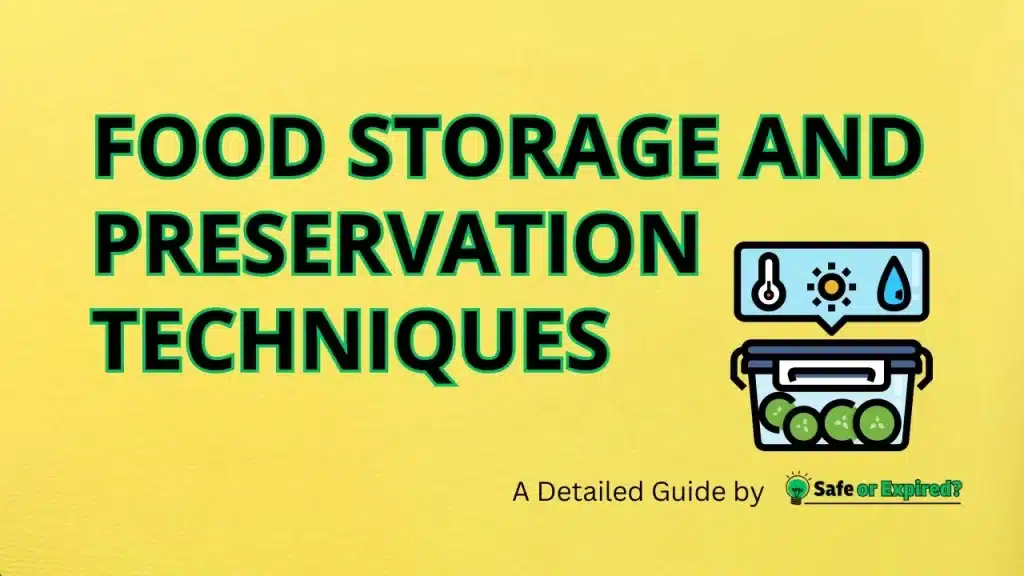Ever wonder how to keep your food tasting fresh longer? Our comprehensive guide on Food Storage and Preservation Techniques is here to show you how. From chilling to freezing and beyond, we dive into easy methods that will change the way you store your food. Get ready and keep reading.
Top 4 Food Storage Techniques – The Ultimate Guide
Food storage techniques are essential for keeping perishables fresh and extending the shelf life of groceries. Key methods include:
- Refrigeration: Slows bacterial growth
- Freezing: Halts microbial activity
- Vacuum sealing: Minimizes oxidation
- Modified atmosphere packaging (MAP): Alters air composition to delay spoilage, ensuring foods remain safe and nutritious.
Refrigeration
| Factor | Details |
| One-line Definition | Uses low temperatures to slow bacterial growth. |
| Types of Food Suitable | Dairy, fruits, vegetables, cooked meals. |
| Pros | Easy to use; maintains freshness and nutritional quality. |
| Cons | Limited shelf life extension; not suitable for all foods. |
Refrigeration slows down bacteria and other microorganisms that cause food spoilage, effectively extending the shelf life of many perishable items. According to BioMed Central, by maintaining foods at temperatures just above freezing point, refrigeration helps preserve:
- Nutritional value
- Texture
- Flavor
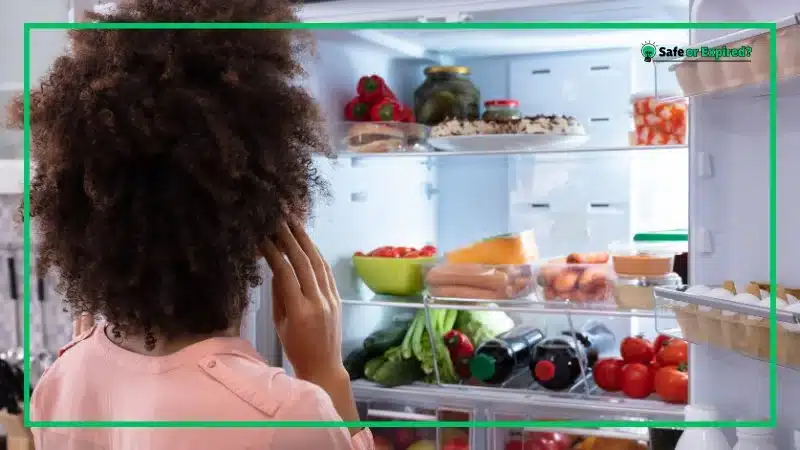
Here are the benefits of proper refrigeration:
- Slows Bacterial Growth: Most bacteria that cause food poisoning grow slowly, if at all, at refrigerated temperatures.
- Maintains Nutritional Value: Keeping food cold preserves its vitamins and minerals.
- Reduces Food Waste: By extending the edible life of food, refrigeration helps households save money and reduce waste.
Here are some tips for optimizing refrigeration for maximum freshness:
- Set the Right Temperature: USDA recommends keeping your refrigerator at or below 40°F (4°C).
- Don’t Overpack: Air circulation is key to maintaining an even temperature throughout the refrigerator.
- Separate Foods: Store raw meat, poultry, and seafood separately from other foods to prevent cross-contamination.
- Know What Not to Refrigerate: Not all foods benefit from refrigeration. Tomatoes, for instance, can lose their flavor and texture; instead, store them at room temperature.
Freezing
| Factor | Details |
| One-line Definition | Preserves food by freezing it at 0°F (-18°C), stopping microbial growth. |
| Types of Food Suitable | Most foods include meats, vegetables, fruits, and prepared dishes. |
| Pros | Extends shelf life significantly; retains nutritional value. |
| Cons | Can affect texture; requires defrosting. |
Freezing food slows down microbial growth and biochemical reactions, extending shelf life. Different techniques like slow freezing or individual quick freezing (IQF) affect the size of ice crystals formed, which can influence the texture and quality of the food when thawed (BioMed Central).
Freezing can also prevent food spoilage and nutrient loss. By bringing the temperature of food below 0°F (-18°C), freezing inhibits the growth of microorganisms and slows down enzyme activity that can cause food degradation. This process preserves food for extended periods without the need for chemical preservatives. So, you can say that it is a natural and effective way to maintain the nutritional quality, taste, and texture of foods.
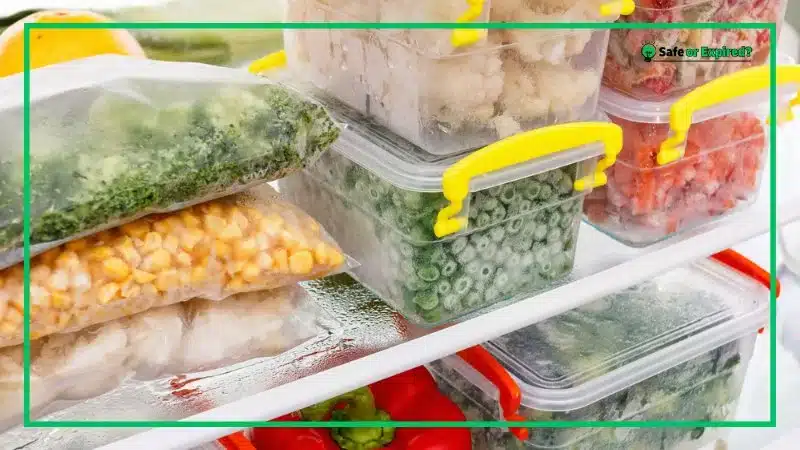
Here are the benefits of freezing
- Long-Term Preservation: Freezing can keep foods safe and maintain their quality for several months and in some cases, even years.
- Nutrient Retention: Properly frozen food retains most of its vitamins, minerals, and antioxidants.
- Seasonal Enjoyment: Freezing allows you to enjoy fruits, vegetables, and other seasonal items year-round.
- Convenience: Having a variety of frozen foods on hand can save time on meal preparation and reduce the frequency of grocery shopping trips.
Here are some tips for effective freezing:
- Prep and Pack Properly: Slice or portion foods before freezing and use freezer-safe bags or containers to minimize air exposure.
- Label and Date: Keep track of what you freeze and when by labeling items with the content and the date of freezing.
- Thaw Safely: Always thaw frozen food in the refrigerator, cold water, or microwave, never on the countertop, to prevent bacterial growth.
- Avoid Freezer Burn: Though it doesn’t make food unsafe, freezer burn can affect taste and texture. It’s usually caused by air reaching the food’s surface, so ensure airtight packaging.
Understanding what causes food to spoil can help you choose the best preservation techniques. For a detailed look at the different factors that contribute to food spoilage, check out “Factors Affecting Food Spoilage: 15 Culprits That Spoil Food.”
Vacuum Sealing
| Factor | Details |
| One-line Definition | Removes air around food to prevent oxidation and spoilage. |
| Types of Food Suitable | Almost all food types, including meats, cheese, vegetables, and dry goods. |
| Pros | Extends shelf life; reduces freezer burn. |
| Cons | Requires special equipment; no visible signs of spoilage. |
Vacuum sealing is one of the best preservation techniques. It involves removing air from a package and then sealing it to create an airtight environment. This process significantly reduces the oxygen content, which eventually inhibits the growth of aerobic bacteria or fungi (University of Minnesota Extension).
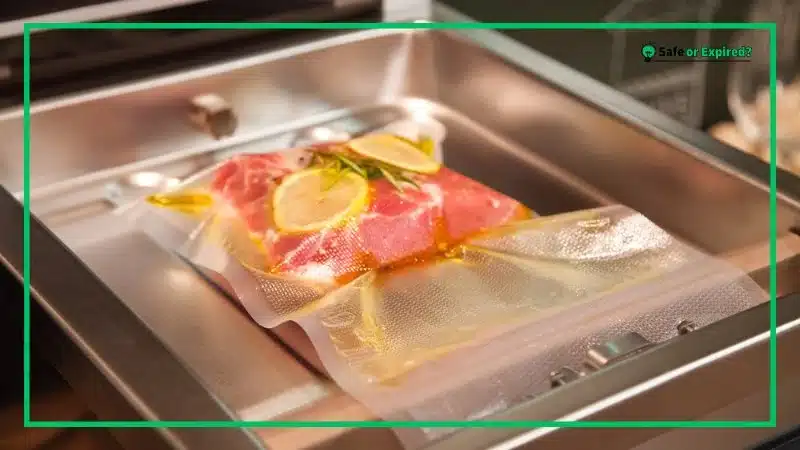
According to Michigan University, these are the benefits of vacuum sealing
- Extended Shelf Life: By removing air, vacuum sealing can extend the shelf life of foods three to five times longer than conventional storage methods.
- Protection Against Freezer Burn: Vacuum-sealed foods are less likely to suffer from freezer burn since there’s no air inside the bag to cause moisture evaporation and ice crystallization.
- Space Efficiency: Vacuum-sealed bags take up less space, allowing for more efficient storage in the fridge and freezer.
- Maintains Food Quality: Vacuum sealing locks in flavor, nutrients, and moisture, ensuring that food tastes as good as it did when it was fresh.
Here are some tips for optimal vacuum sealing:
- Choose the Right Bags: Use bags specifically designed for vacuum sealing to ensure they’re strong enough to resist punctures and seal properly.
- Prep Foods Before Sealing: For wet foods, consider pre-freezing sauces or liquids in a container before vacuum sealing. For delicate foods, a protective barrier can prevent crushing.
- Label and Date: Keep track of what you’ve sealed and when by labeling each bag with the contents and the date.
- Regular Maintenance: Ensure your vacuum sealer is clean and functioning properly to maintain its effectiveness and longevity.
While learning about effective storage techniques, it’s important to avoid common pitfalls. Many myths about food preservation circulate that can be misleading. To ensure you’re not falling for these, read this guide: “10 Misleading Food Preservation Myths Exposed.”
Modified Atmosphere Packaging (MAP)
| Factor | Details |
| One-line Definition | Alters the atmosphere inside packaging to extend shelf life. |
| Types of Food Suitable | Fresh produce, meats, dairy, and ready-to-eat foods. |
| Pros | Extends freshness without preservatives; maintains color and texture. |
| Cons | Can be costly; specific gasses are needed for different food types. |
Modified Atmosphere Packaging (MAP) is a cool way to package food that makes it stay fresh longer. It works by reducing the amount of oxygen inside the packaging. Oxygen can make food spoil faster by helping bacteria grow and by reacting with the food itself. By using gasses like nitrogen and carbon dioxide to replace some or all of the oxygen, MAP can significantly slow down these processes.
These are the benefits of MAP:
- Longer Shelf Life: Foods last longer on store shelves and in your fridge, reducing waste.
- Maintains Quality: Keeps the color, texture, and flavor of food better over time.
- Reduces the Need for Preservatives: With MAP, there’s less need to add chemical preservatives to food.
- Versatile: It’s used for a wide range of foods, from fresh produce and meats to baked goods and coffee.
Here’s how MAP is used:
- In the Grocery Store: Lots of the fresh food you buy, like salads or pre-cut fruits, are packaged this way.
- For Meat and Fish: Helps keep these products fresh from the store to your home.
- Snacks and Coffee: Keeps them crisp and flavorful longer.
But wait. There are some things to Know About MAP:
- Safety First: MAP doesn’t replace good food safety practices. Always store and handle food properly.
- Environmentally Friendly Options: Some worry about the environmental impact of packaging. The good news is there are more eco-friendly MAP options being developed.
- Check Dates: Even with MAP, it’s important to check the “use by” dates and consume food while it’s fresh.
9 Food Preservation Techniques That Extend Shelf Life Effortlessly
Food preservation techniques include drying, canning, freezing, pickling, fermenting, and salting. Each follows different principles to inhibit spoilage and microbial growth. Modern techniques like irradiation, and high-pressure processing offer innovative ways to keep food fresh longer.
Canning
| Factor | Details |
| One-line Definition | Seals food in airtight containers to prevent spoilage. |
| Types of Food Suitable | Fruits, vegetables, meats, and soups. |
| Pros | Long shelf life; wide range of suitable foods. |
| Cons | Labor-intensive; risk of botulism if done improperly. |
Canning is a preservation method that involves processing food in airtight containers at high temperatures to kill harmful bacteria and enzymes, then sealing it to prevent new bacteria from entering. This technique allows food to be shelf-stable for years, preserving its taste, nutritional value, and safety without the need for refrigeration. From jams and jellies to vegetables and meats, canning is versatile, making it a favorite among home cooks and the food industry alike.

These are the benefits of canning:
- Long Shelf Life: Properly canned foods can be stored for years, reducing food waste and ensuring a supply of out-of-season or surplus produce.
- Nutritional Preservation: Canning immediately after harvesting helps lock in nutrients at their peak.
- Eco-Friendly: It reduces the need for refrigeration and offers a sustainable way to preserve food, especially when using locally sourced produce.
- Customization: Home canning allows for creativity in recipes and flavors, giving you control over what goes into your food.
Check out these tips for successful canning:
- Choose the Right Method: Use water bath canning for acidic foods like fruits and tomatoes. For low-acidic foods, you should go for pressure canning.
- Follow Tested Recipes: Precise acidity, sugar, and salt levels are crucial for safety. Use recipes from reliable sources.
- Inspect Your Equipment: Check jars for cracks and lids for seals to ensure airtight storage.
- Practice Food Safety: Sterilize jars and follow cleanliness protocols to prevent contamination.
Knowing and following the guidelines set by top safety institutions is key to proper food handling. Learn about the standards and recommendations from the leading authorities in “Food Safety Guidelines by Top 4 Institutions.”
Drying
| Factor | Details |
| One-line Definition | Removes moisture to inhibit the growth of microorganisms. |
| Types of Food Suitable | Fruits, vegetables, meats, herbs. |
| Pros | Long shelf life; lightweight and portable. |
| Cons | Can change texture and flavor; requires careful storage. |
Drying involves removing water from food, thereby inhibiting the growth of bacteria, yeasts, and mold through dehydration. You can simply place the food (fresh produce) in the open air and let the air and light dry it.
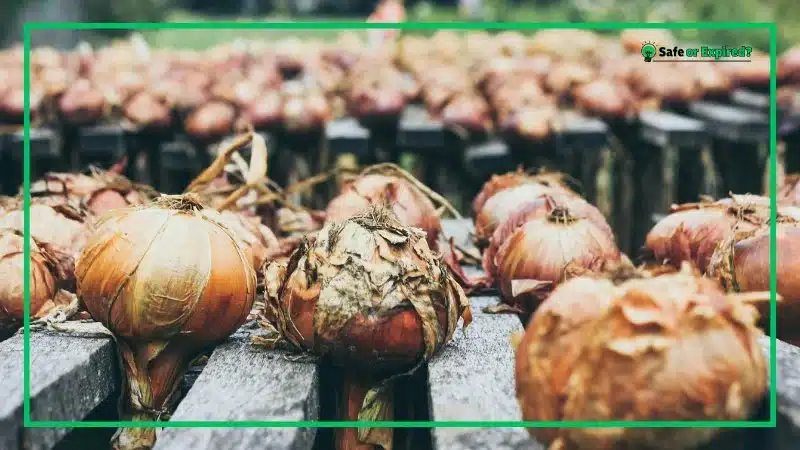
Now, researchers are trying various innovative drying technologies that enhance food quality while ensuring energy efficiency. For example, hybrid drying techniques combine different drying methods to optimize energy usage and maintain the nutritional and sensory qualities of food products.
Advances in drying technology also include the use of microwaves, radio frequency, and infrared drying, which are particularly effective in reducing drying times and improving energy consumption (MDPI).
These are the benefits of drying foods:
- Extended Shelf Life: Dried foods can last for months or even years when stored properly in a cool, dark place.
- Nutrient Preservation: While some vitamins may be reduced during drying, minerals and fiber remain intact, making dried foods a nutritious snack option.
- Convenience and Portability: Dried foods are lightweight and easy to store, perfect for camping, hiking, or as a quick snack.
- Flavor Enhancement: Drying can concentrate flavors, making dried foods more flavorful than their fresh counterparts.
Here are some tips for effective food drying:
- Select the Right Method: Options include air drying, oven drying, and using an electric dehydrator. Each method has its advantages depending on the type of food and desired outcome.
- Prepare Foods Properly: Slice foods uniformly to ensure even drying. Blanch vegetables to stop enzyme activity that can spoil the food during storage.
- Monitor the Drying Process: Check regularly to avoid over-drying, which can lead to hard, unpalatable foods.
- Store Correctly: Once dried, foods should be stored in airtight containers in a cool, dark place to maintain quality and extend shelf life.
Fermentation
| Factor | Details |
| One-line Definition | Uses microbes to convert sugars into acids, gasses, or alcohol, preserving food and enhancing flavors. |
| Types of Food Suitable | Vegetables (sauerkraut, kimchi), dairy (yogurt, cheese), meats (salami), and beverages (kombucha, beer). |
| Pros | Adds beneficial probiotics; enhances flavor and digestibility. |
| Cons | Requires controlled conditions; potential for undesirable bacteria if not done properly. |
Fermentation is all about using natural bacteria and yeast. In it, you convert food’s sugars and starches into alcohol or acids. This not only preserves the food but also creates distinctive flavors, aromas, and health benefits, such as improved digestion and added nutrients.
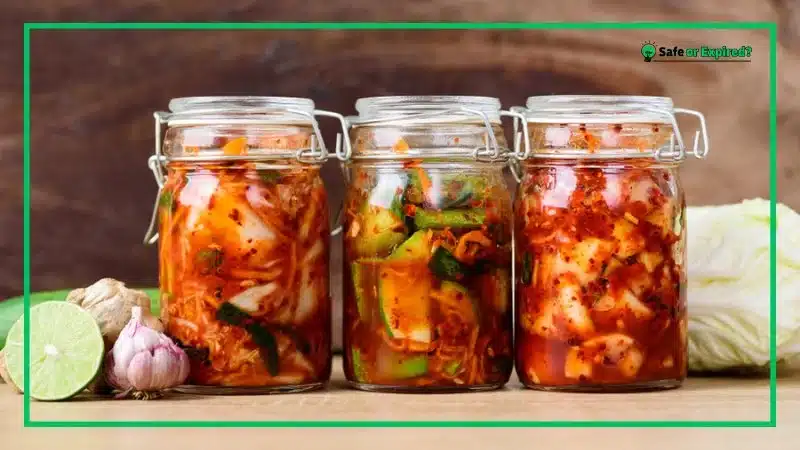
These are the benefits of fermentation:
- Enhanced Nutrition: Fermentation can increase the availability of vitamins and minerals for our body to absorb, making fermented foods potent nutritional powerhouses.
- Digestive Health: Many fermented foods contain probiotics, beneficial bacteria that can boost gut health.
- Flavor Development: Fermentation introduces unique flavors and textures that are not achievable through other cooking or preservation methods.
Check out these tips for successful fermentation:
- Sterilize Your Equipment: Before beginning, ensure all containers and utensils are clean to avoid contamination.
- Choose Quality Ingredients: Use fresh, organic produce and high-quality starters.
- Monitor Temperature and Time: Most fermentations require specific temperature ranges and timeframes to develop the desired flavors and textures.
- Taste Test: Fermentation is not an exact science. Taste your ferment at different stages to determine when it has reached its peak flavor.
Pickling
| Factor | Details |
| One-line Definition | Preserves food in an acidic solution or brine. |
| Types of Food Suitable | Vegetables, fruits, eggs, and meats. |
| Pros | Adds unique flavors; no need for refrigeration. |
| Cons | High sodium content; specific taste not suitable for all foods. |
Pickling is preserving food by immersion in vinegar or brine (salt water). In it, you create an acidic environment. Note that most bacteria cannot survive in a low-pH (acidic) environment. Pickling can be found in cuisines worldwide, each offering its own variety of pickled delicacies, from the dill pickles of North America to the kimchi of Korea.
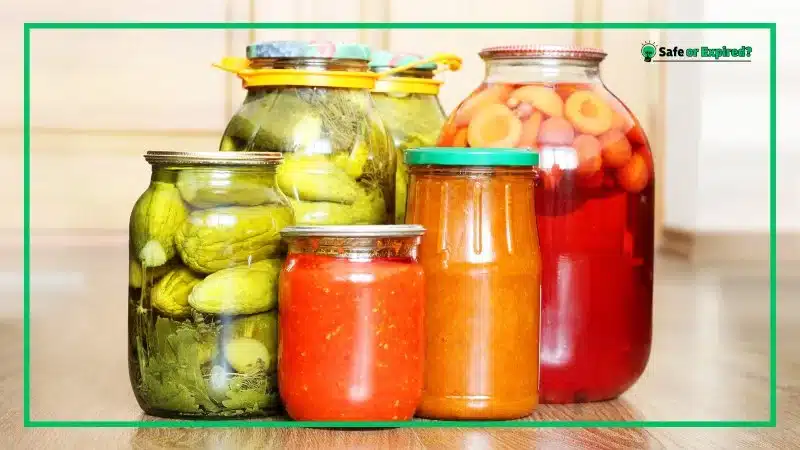
Here are the benefits of pickling:
- Preserve Seasonal Produce: Pickling allows you to enjoy the bounty of seasonal fruits and vegetables throughout the year.
- Adds Nutritional Value: Many pickled foods are rich in vitamins and probiotics, which can aid digestion and boost the immune system.
- Low in Calories: Pickled vegetables are low in calories.
- Flavor Enhancement: The pickling process introduces a depth of flavor, adding a tangy or spicy kick to meals.
Here are some tips for successful pickling:
- Vinegar Quality Matters: Use high-quality vinegar for the best taste. The type of vinegar used can significantly influence the flavor of your pickles.
- Experiment with Spices: Don’t be afraid to experiment with various spices and herbs to create unique flavor profiles.
- Keep Everything Clean: Ensure jars and utensils are sterilized to prevent contamination and ensure the longevity of your pickles.
Salting
| Factor | Details |
| One-line Definition | Uses salt to draw moisture out of food, inhibiting microbial growth. |
| Types of Food Suitable | Meat, fish, and some vegetables. |
| Pros | Long shelf life; enhances flavor. |
| Cons | Can make food too salty; requires thorough rinsing before use. |
Salting is a way to keep food from going bad by using salt. People have used salt for a very long time to keep meat and fish fresh. It works by taking water out of the food, which makes it hard for bad germs to grow. Salting is not just for keeping food safe; it also makes food taste better and can change the way food feels when you eat it.
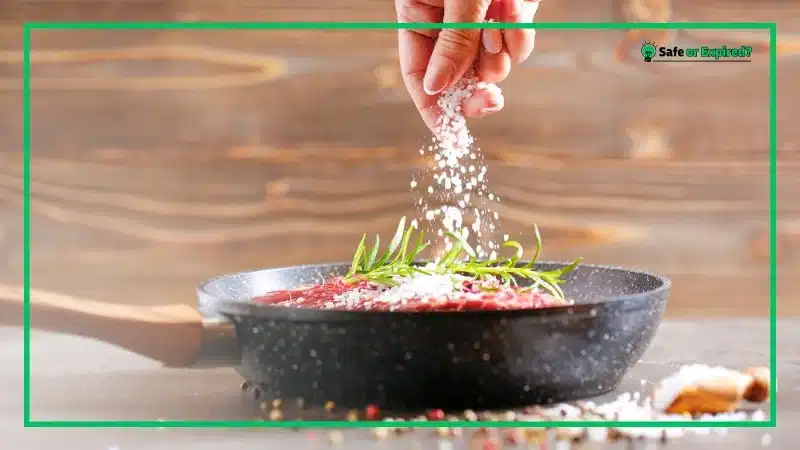
Check out the benefits of salting:
- Longevity: Salting significantly extends the shelf life of foods by creating an environment where spoilage organisms struggle to survive.
- Flavor Enhancement: Beyond preservation, salt penetrates food, enhancing its natural flavors and improving taste.
- Texture Modification: The process of salting can also alter the texture of food, often resulting in a firmer, denser product that adds variety to meals.
- Nutrient Retention: Salting helps retain many of the food’s nutrients that might be lost through other preservation methods.
Here are some tips for successful salting:
- Choose the Right Type of Salt: Different salts (table salt, kosher salt, sea salt) have different properties and flavors. Kosher salt is commonly used for its purity and texture.
- Control Salt Proportions: Too much salt can make food inedible, while too little may not preserve it effectively. Follow recipes closely to find the right balance.
- Cure Evenly: When salting meats or fish, ensure the salt is evenly distributed to cure the food uniformly.
- Store Properly: After salting, store food in a cool, dry place to maximize preservation and maintain quality.
Sugaring
| Factor | Details |
| One-line Definition | Uses sugar to draw moisture out of food, reducing microbial growth. |
| Types of Food Suitable | Fruits, sweet preserves. |
| Pros | Preserves color and texture; adds sweetness. |
| Cons | High-calorie content; not suitable for all diets. |
Sugaring is a neat trick to keep your food tasty and safe for longer. By mixing food with sugar, it pulls water out, just like using a sponge. This means there’s no room for germs that make food go bad. It’s a favorite way to keep fruits yummy, turning them into jams, jellies, or even dried snacks. Not only does it keep the fruit good for months, but it also adds a delicious, sweet flavor.
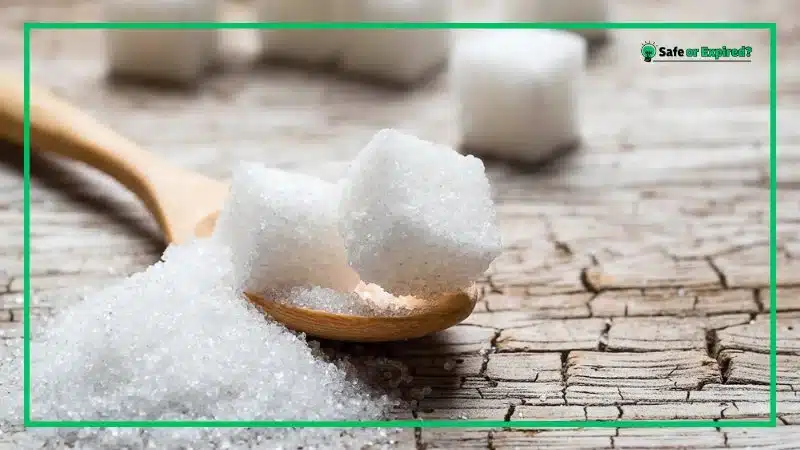
These are the good things about sugaring:
- Keeps Food Good for Longer: Sugar acts as a shield against bad germs.
- Tastes Great: It adds a sweet kick to whatever you’re preserving.
- Easy to Do: You don’t need fancy equipment to start sugaring at home.
- Versatile: You can sugar almost any fruit, and even some vegetables, for a different taste.
Here are some tips for perfect sugaring:
- Just Enough Sugar: Find the sweet spot in how much sugar to use. Too little won’t preserve well, and too much can be overwhelming.
- Keep It Clean: Make sure everything is clean before you start. This helps keep your food safe.
- Be Patient: Some sugaring methods, like making jelly, need time to set properly.
- Store Right: Keep your sugared goodies in a cool, dry place to make them last.
Irradiation
| Factor | Details |
| One-line Definition | Uses ionizing radiation to eliminate microorganisms and extend shelf life. |
| Types of Food Suitable | Spices, fruits, vegetables, meats, and seafood. |
| Pros | Kills bacteria and parasites; does not leave residues. |
| Cons | Consumer acceptance issues; requires special equipment and approval. |
Irradiation is a sophisticated method that involves exposing food to controlled amounts of ionizing radiation, a process that can effectively eliminate bacteria, viruses, and pests. Unlike chemical treatments, irradiation doesn’t leave any residue behind, and contrary to common misconceptions, it does not make the food radioactive.
Here are the benefits of Irradiation:
- Enhanced Safety: It reduces the risk of foodborne illnesses by destroying harmful pathogens like E. coli and Salmonella.
- Longer Shelf Life: By killing spoilage-causing microorganisms, irradiation extends the freshness and usability of various foods.
- Pest Control: It’s an effective way to control insect infestation in grains and fruits without using chemical pesticides.
- Nutrient Preservation: The process is known to preserve the nutritional value of food better than some traditional preservation methods.
Here’s how Irradiation is applied:
- Food is Exposed to Radiation: The food passes through a radiation chamber where it’s exposed to a precise dose of ionizing radiation.
- Controlled Conditions: The amount of radiation and the duration of exposure are carefully controlled. This is done to ensure safety and effectiveness.
- Regulatory Approval: Foods treated with irradiation are subject to strict regulatory standards. This is done to ensure they are safe for consumption.
Chemical Preservation
| Factor | Details |
| One-line Definition | Adds chemicals to food to prevent spoilage and kill harmful organisms. |
| Types of Food Suitable | Processed foods, drinks, canned goods, and dairy products. |
| Pros | Effective at extending shelf life; prevents growth of pathogens. |
| Cons | Potential health concerns; may alter taste or nutritional value. |
Chemical preservation involves adding substances to food to keep it from spoiling. These substances can stop or slow down the growth of bacteria, molds, and yeast that cause food to go bad. This method is widely used because it’s effective and can be applied to many types of food, from canned goods to bread and beverages.
Why use chemical preservatives?
- Extend Shelf Life: Chemicals can keep food fresh for longer, reducing waste and saving money.
- Maintain Quality: They help maintain the color, texture, and flavor of food as it sits on store shelves or in your pantry.
- Prevent Illness: By stopping the growth of harmful microbes, chemical preservatives can help prevent foodborne illnesses.
These are the common Chemical Preservatives:
- Sorbates (like potassium sorbate): Used in cheeses, wines, and baked goods to stop molds and yeasts.
- Nitrites and Nitrates: Added to meats like bacon and hot dogs. They can prevent bacterial growth and keep the meat’s red color.
- Sulfites: Used in dried fruits and wines to prevent browning and spoilage.
Here’s how to use Chemical Preservatives safely:
- Read Labels: Always check food labels to know what preservatives are in your food.
- Follow Recommendations: Use preservatives according to recipe or product instructions to ensure safety and effectiveness.
- Be Mindful of Allergies: Some people may be sensitive or allergic to certain chemical preservatives.
While chemical preservatives play a crucial role in modern food preservation, there’s ongoing debate about their health impacts. Most are considered safe by food safety authorities when used correctly. However, some people prefer to minimize their intake of artificially preserved foods, opting for fresh, frozen, or naturally preserved alternatives.
Additionally, understanding how food safety authorities worldwide work to protect our food from harmful chemicals is also important. Discover more in “7 Food Safety Authorities: How They Protect Our Foods!”
High-Pressure Processing (HPP)
| Factor | Details |
| One-line Definition | Uses high pressure to inactivate bacteria, viruses, and enzymes. |
| Types of Food Suitable | Juices, meats, seafood, and ready-to-eat meals. |
| Pros | Retains nutrients and taste; extends shelf life. |
| Cons | High cost; requires specialized equipment. |
High-Pressure Processing (HPP) is like giving food a deep-sea dive. This method uses extreme pressure (not heat. Foods are placed in water and then subjected to pressures that are thousands of times higher than the air pressure we’re used to.
This squashes harmful bacteria and viruses without cooking the food, keeping its taste, texture, and nutrients almost fresh.
These are the benefits of HPP:
- Tastes Fresh: Because it doesn’t use heat, food keeps its just-picked taste.
- Stays Nutritious: Vitamins and nutrients don’t get lost in the process.
- Clean Label: Allows for fewer additives and preservatives in food, appealing to those wanting a more natural diet.
Where you’ll find HPP Foods:
- Juices and Smoothies: HPP keeps them tasting fresh off the tree or vine.
- Ready-to-Eat Meals: Perfect for keeping meals safe and delicious, especially when you’re short on time.
- Seafood and Meats: Keeps these high-risk foods safer to enjoy.
- Dips and Sauces: They stay flavorful and safe, from guacamole to tomato sauce.
Things to consider about HPP:
- Not for All Foods: Some foods can change in texture under high pressure.
- Cost: HPP can be more expensive due to the technology involved, which might reflect on the product price.
- Packaging Matters: Foods need to be in flexible packaging to withstand the pressure, affecting how products are presented and stored.
Concluding Food Storage and Preservation Techniques
Embracing proper food storage and preservation techniques is key to minimizing waste, saving money, and enjoying your meals to their fullest. Whether you’re a cooking enthusiast or just looking to make your groceries last longer, these methods offer something for everyone. Remember:
- Cool is Key: Refrigeration and freezing slow down spoilage effectively.
- Dry and High: Drying and salting pull water away, making it hard for bacteria to grow.
- Packaging Matters: Modern methods like vacuum sealing and MAP protect against air and moisture.
- Natural Helpers: Don’t forget about natural preservatives like sugar, salt, and vinegar for added longevity.
- Stay Informed: Understanding what techniques work best for different types of food ensures you always get the best from your groceries.
Harnessing these techniques can revolutionize the way you handle food at home, ensuring that freshness lasts as long as possible.

